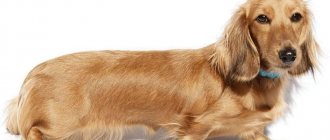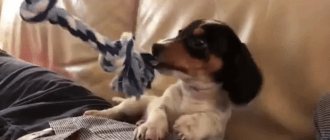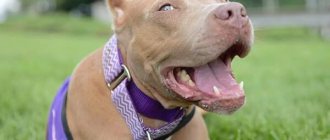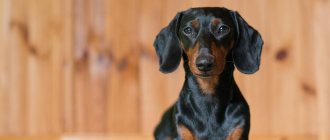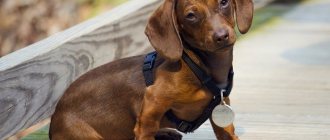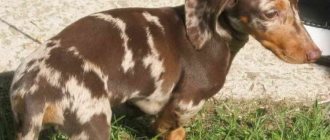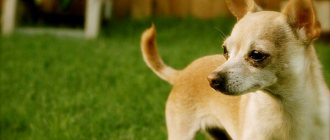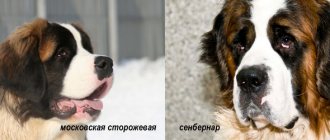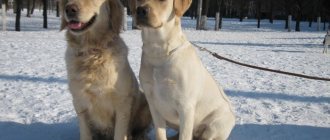Miniature dogs are popular among livestock breeders. They are easy to care for in apartments and private houses. Dwarf dachshunds not only adapt well to any living conditions, but also belong to the group of hunting dogs. You should consider in more detail the features of caring for your pet and information about how much a dwarf dachshund costs.
Origin story
The ancient Egyptians painted dogs that looked like dachshunds, but it is now impossible to determine whether it is a dachshund or a lack of artistic skills. Short-legged, long dogs with floppy ears were also depicted by the ancient Greeks.
Many dachshund skeletons have been found in Germany. They date back to the heyday of the Roman Empire, and where the excavations were carried out, there were Roman settlements.
Dachshunds do not have high speed qualities, they do not have an amazing sense of smell, they do not follow the animal’s scent, and their appearance makes you smile. However, this is a hunting breed.
The purpose of the dachshund is burrow hunting. The elongated body and short legs allow the dog to maneuver in narrow holes where the animal hides.
The main prey of dachshunds is badgers.
Badgers ravaged the fields, and getting them out of their holes was quite a task.
The dachshunds managed. The name of the breed came from the game: “daxa” - “badger”. Another name for the breed is “daxhund” - “badger hound”.
Even a specialized dog could not penetrate all the holes, so reducing the size of the badger hound is the cherished dream of German hunters. If a smaller puppy appeared in the litter, hunting enthusiasts were ready to pay decent money for the baby.
Serious breeders specializing in dachshunds appeared in the 17th century. True, everyone had their own idea of the appearance of a working dog. The dogs were very different from each other.
It was possible to achieve sustainable results in breeding miniature representatives of the breed only at the beginning of the 20th century. It was at this time that the standard recognized three varieties of dachshund: standard, dwarf and rabbit. Dwarf - larger than a rabbit, but smaller than a standard one.
There are fewer hunters, and badgers and foxes are not the kind of prey that modern hunting enthusiasts dream of. Therefore, dachshunds are used mainly as companions.
Coat types
- Smooth-haired. The coat does not exceed 1 cm in length, smooth, close to the body, not rough. The undercoat is also short, soft, but not fluffy.
- Long-haired. On the body, limbs and ears, the hair is wavy, thick and quite long - from 5 to 10 cm. On the head it is short, smooth and close-fitting.
- Wirehaired. The coat is short - up to 3 cm, wiry, thick and dense. On the face it forms eyebrows, mustache and beard, typical for this variety.
Marriage or separate breed
Dachshunds are originally the result of a disease or mutation. Dachshund is a dwarf breed. But the mutation turned out to be useful and was fixed. Reduction in size is also the result of targeted selection. Thanks to the efforts of specialists, the breed standard recognizes three varieties of dachshunds, differing in size.
The Miniature Dachshund is one of the breed varieties. Can take part in exhibitions, competitions, win titles. The character and skills of all varieties of dachshunds are almost identical.
Popular nurseries
- Golden Daxhund, Moscow region, Odintsovo
- From Omsk Fortress, Omsk
- Caladium Vis-a-vis, Moscow
- Caroline Yudzhel, Moscow
- Kinchville, Moscow
- Fox Nose, St. Petersburg
- Minidogland, Smolensk
- Myshkin House, Moscow
- Magic Rainbow, St. Petersburg
- Norden Licht, Moscow
- Rus Bramers, Moscow
- From the Marvelous Mountains, Krasnoyarsk Territory, Divnogorsk
- Stayer's, Tula
- Formula for success, Moscow
- Certus, St. Petersburg
You can easily find the websites of these nurseries on the Internet, as well as the coordinates of their owners.
Characteristics and description of the breed
A mini dachshund is a smaller copy of a standard representative of the breed. The same characteristic features, the same possible colors, the same types of coat.
Color and coat type
The dwarf mini dachshund has three types of coat. All three are recognized as standard:
- smooth coat – short-haired dachshunds are ideal for home keeping. Short hair does not require effort to maintain in good condition;
- long hair is the choice of connoisseurs who have enough time to devote to caring for their beloved pet. The investment of time and effort is colossal; dachshunds with such hair are used only as decorative dogs, no hunting;
- Coarse hair – these are the types of dachshunds that are usually used for hunting. Thick, coarse wool helps to withstand difficult weather conditions and work in dense thickets, and its care is generally hygienic.
The choice of colors is quite large:
- Monochrome. Usually – shades of brown: from sand to chocolate.
- Two-color. The main background is black or brown, the tan marks are light shades of brown.
- Marble. The main background is black, gray, dark red. It has light gray or cream spots, without symmetry.
- Brindle. Dark red or sandy wool changes tone in stripes - lighter and darker.
- There are white dwarf dachshunds, but they are excluded from the standard.
Dimensions and weight of an adult dog
- The height at the withers of a dwarf dachshund can vary from 14 to 21 centimeters.
- An adult dwarf dachshund weighs from 4 to 5.5 kilograms.
What is the difference between a standard dachshund and a rabbit
The differences between dachshunds are in size:
- standard – 20-27 centimeters high, weighing up to 9 kilograms;
- dwarf - 14-21 centimeters high, weighing 4-5.5 kilograms;
- rabbit - no higher than 15 centimeters, weighing about 3.5 kilograms.
The lower range of the dwarf dachshund overlaps with the rabbit (up to 15 centimeters), and the upper range overlaps with the standard one (from 20 centimeters), but weight also matters. With the same growth rates, a standard dachshund will be more massive, and a rabbit dachshund will be smaller.
Interesting Facts
Many interesting facts are known about mini-rabbit dachshunds. For example:
- The rabbit dachshund was the favorite breed of Emperor William II of Germany, which is why such dogs suffered persecution during World War II. They were even considered a symbol of the enemy.
- Sometimes the breed is called not a rabbit, but a hare.
- No breeder can guarantee that as a rabbit dachshund matures it will not turn into a miniature one.
The rabbit dachshund is an ideal and cheerful companion. The miniature dog will become a true friend not only to the owner, but also to his entire family.
Features of character and behavior
The dwarf dachshund puppy fits the stereotype of a “small dog.”
He is playful, overly curious, and energetic. Even in a dream, the baby runs somewhere, twitching its paws, whining, yapping. The situation changes with age. The dwarf dachshund becomes serious, concentrated, unhurried, although immoderate curiosity still remains. An adult dog behaves in the same way as its larger relatives. The reduction in size did not affect the character.
Independent decision-making, intelligence and sincere friendliness towards “their own” make up the character of an adult dwarf dachshund.
The stubbornness that dog handlers attribute to all dachshunds is precisely independence. During the hunt, the ancestors of dachshunds were guided by their own ideas about the correctness of decisions - it was on them that the life of the dog in the predator’s hole depended. Over the centuries, representatives of the breed have developed caution and prudence. The hunter outside could do nothing to help the dog. And now the dachshund, having heard the command, will first think about it. If her opinion coincides with the owner’s requirement, then the command will be impeccably executed. But if the dog believes that the command is inappropriate in this situation, then it will not even think about executing it.
A warm and respectful attitude on the part of the dachshund requires reciprocal respect for its personal space and from members of the household. Attempts to invade can also end in a painful bite: the dachshund will show that it is dissatisfied.
The dwarf dachshund cannot imagine life without society. She needs communication and movement around. A dog left alone for a long time will not fail to express dissatisfaction and boredom on the surrounding furnishings and clothes of inattentive owners.
Representatives of the breed are keenly aware of injustice. An unjustified sharp shout, the use of force, or deception seriously offends the dachshund. And an offended dwarf dachshund is scary. If the owner does not apologize, he will not be pleased with the consequences. A lot of little dirty tricks that a small dog can come up with will come into play. Heaps and puddles, damaged clothes and shoes, an “accidentally” dropped vase: the dog is waiting for an apology.
A treat is quite suitable as an apology. A dwarf dachshund is ready to forgive a lot for a piece of its favorite food. The love for food and comfort is the weak point of the breed. The dachshund will not allow anyone to choose his place to rest. And if the owner tries to move the bed to the side, after a while it will again end up in its original place.
There are usually no problems with other pets. A dachshund is always for good company. More communication, more activity.
Breed and children
A dwarf dachshund will have no problem playing and cuddling with a child. But this will happen as long as he does not cause her any inconvenience. Excessive persistence, invasion of personal space, and pain can result in a bite.
Children will have to be taught the simple rules of living with a dachshund. A dog's attitude is largely up to them. Initially, representatives of the breed are very friendly.
Pros and cons of the breed
The dwarf dachshund has its own difficult character. Living together with this dog is not easy, but interesting.
Pros:
- The apartment is quite suitable for a dwarf dachshund.
- If the dog is not long-haired, there will be no problems in grooming.
- Dachshunds are clean and take care of themselves.
- Friendliness and desire to communicate.
- Hassle-free travel together.
- Gets along with other animals.
- Subject to simple rules, he treats children well.
- Can perform guard duties.
Minuses:
- Stubbornness: The dachshund first develops its own understanding of the situation, and then decides whether to comply with the owner’s request.
- High demands for activity. You will have to walk a lot with your dwarf dachshund.
- Can't stand being alone for long periods of time.
- A bite may be a reaction to an insult.
- Serious tendency towards obesity.
- Problem spine.
Briefly about the main thing
- The pygmy dachshund was created to chase small burrowing animals;
- This breed variety has the same features and proportions as the standard dachshund, only smaller;
- Dachshunds come in a variety of coat lengths and colors;
- Hunters by nature, they are active, stubborn, and have a clear voice;
- It is not recommended to keep a dachshund with other pets, especially rodents and birds;
- Training a puppy begins from the first days in a new home;
- The pet is prone to overeating and needs a special regime.
Care and maintenance
Dwarf dachshunds need a warm room, and it doesn’t matter whether it’s a house or an apartment. Representatives of the breed cannot live outside - short hair does not protect dachshunds from bad weather.
Hygiene
When it comes to grooming, coat type makes a big difference:
- Dachshunds with smooth coats are the most trouble-free: they don’t need a haircut, and brushing them out in a few minutes with a mitten is easy;
- The dachshund's rough coat requires hygienic trimming: under the tail, between the toes, beard, mustache and eyebrows, and combing is as simple as for smooth-haired representatives of the breed;
- Taxes with long hair require serious brushing at least 2-3 times a week, in addition, they will need a hygienic haircut, and if the dog participates in shows, then a professional hairdresser.
water treatments . A damp cloth is enough. Individuals with long hair will have to be bathed 2-3 times a year, using appropriate shampoos. Before exhibitions, cosmetics are used.
eyes and ears require constant monitoring. It is advisable to examine your ears two to three times a week for infections, redness, and inflammation. Eyes should be washed once a week. The ears will need to be cleaned once every two weeks using a cotton swab and lotion. Dachshunds are active, and the use of cosmetic sticks is not recommended - there is a high risk of injuring the animal with sudden movement.
Nails are trimmed as needed using a nail clipper. In the warm season, the dwarf dachshund wears them down on hard surfaces. In winter, the procedure will have to be performed more often.
Brushing your teeth is recommended once a week. Preventing tartar and plaque helps avoid expensive and unpleasant dental procedures for your pet. A special “dog” paste and brush are used.
Feeding
The increased tendency to obesity in dachshunds requires the owner's attention to diet and portion size. A food lover will definitely try to beg for an extra piece, but for the sake of the pet, you shouldn’t give in.
During puppyhood, breeders recommend only natural products. If the new owner wants to switch the dwarf dachshund to dry food, this is done gradually, and only in adulthood.
Dry food for dwarf dachshunds is no lower than premium food, observing the serving size indicated on the package. All the necessary vitamins and minerals are contained in such feeds.
Natural feeding of a dachshund implies a varied diet:
- boiled lean meat without bones;
- boiled sea fish without bones;
- buckwheat, millet, oatmeal;
- low-fat fermented milk products;
- fruits and vegetables;
- boiled chicken eggs.
The following must be completely excluded from the diet:
- smoked, salted, spicy dishes;
- sweet and flour products;
- fatty and raw meat, sausage;
- legumes
The number of feedings is strictly regulated based on the age of the dog:
- puppies up to 6 months – 5-6 times a day;
- adolescents from 6 to 12 months – 3 times a day;
- dogs from one year old - 2 times a day.
Walking and physical activity
The curiosity and activity of the dwarf dachshund leaves no choice for the owner: walks must be long and the routes must be different.
The minimum number of walks is 2 per day, 45 minutes each. Better is more. The Dachshund is an excellent hiking companion. A trip to the forest, to the country house, to the lake will be a real holiday for a small pet. The dwarf dachshund will not cause problems, but will have a lot of fun.
The dachshund has a physiological peculiarity: it easily slips out of standard collars, so a vest-harness is used for walking.
When walking in public places, it is better not to let your baby off the leash: she will not cause trouble for anyone, but she may get carried away by hunting cats and birds.
The peculiarity of the dachshund's body structure excludes training in overcoming obstacles and requires caution when jumping. They even carry a dachshund puppy for a walk in their arms so that it does not go down the stairs.
What actions with mini-dachshunds are unacceptable?
The main part of the dangers for a pet is associated with its small size and physique. Until they are six months old, you should not leave your dachshund unattended on the sofa. There is a high probability of damage to the spine and limbs after a jump from a height.
When going down the stairs on your own, the load on the front legs and spine increases. The baby is picked up to eliminate the risk of curvature of the paws and displacement of the vertebrae.
Accustoming to a new type of food and switching from one to another must be done gradually so as not to cause disturbances in the gastrointestinal tract.
Mini-sized dachshunds are vaccinated in accordance with the vaccination calendar and only after deworming.
You should not play tug-of-war with your pet until the teeth and bite are fully formed to avoid deformation and misalignment of the jaws.
During training, mini taxis should not be indulged; they should know and feel who is boss.
Training and education
You will have to start raising a dwarf dachshund from the very first day of its appearance in the house. If something was allowed, and then became prohibited, the dachshund will not understand and will not approve. Choosing a place to rest, food, toilet, rules and prohibitions - everything should come into play right away.
There is no doubt that the cunning little dachshund will try to convince you that there is no need to prohibit anything. Charm, charisma, unhappy and sad eyes will be used. It is important to understand that this is pure manipulation.
Correctness is the basis of successful education and training. It is forbidden to hit a dwarf dachshund, and it is forbidden to shout at it. This will lead to resentment and resistance from the dog. Perseverance, confidence and a kind attitude - this is what you need to arm yourself with when taking on the task of raising a dachshund. Positive motivation is a treat. The dachshund will go all out for his favorite food.
The learning process is best done on an empty stomach. Commands are not repeated twice: a cunning child will immediately understand that they don’t have to follow them the first time. The dwarf dachshund perfectly learns what is required of it, so you can start teaching simple commands right away.
Owner reviews
As a rule, owners speak extremely positively about their miniature pets. At the same time, everyone unanimously declares that a lot of effort must be made to turn a disobedient dachshund into an obedient pet. In addition to the fact that the little dachshund has considerable intelligence, this dog is vindictive, cunning and vindictive.
Important point! Finding a common language with this pet is not so easy, but if this happens, then you can count on the loyalty and devotion of this dog.
The owners also claim that the dachshund will not eat everything, showing selectivity in food. She herself decides where she sleeps, so you need to be prepared for the fact that she will sleep next to her owner and in his bed. You will have to walk him every couple of hours, even if the dachshund went to the toilet in the litter tray. By constantly paying attention to this pet, you can count on reciprocity.
Svetlana Lushkina: “The rabbit dachshund is a dog with a masculine hunter’s mind” | Elite | Sergiev Posad
Diseases and life expectancy
13 years is the average lifespan of a dwarf dachshund. Whether a pet can live longer depends on diet, activity and living conditions.
The dwarf dachshund has quite a lot of propensities for diseases.
- Obesity.
- Diabetes.
- Spinal diseases.
- Problem joints.
- Swimmer's syndrome.
- Eye diseases.
- Skin diseases.
- Dental problems.
- Epilepsy.
- Highly traumatic.
Mating
Before reaching 2 years of age, you should not breed a dwarf dachshund: the body and psyche are not yet fully formed, and early pregnancy will have a negative impact on both the mother and the offspring.
Before mating, it is advisable to visit a veterinary clinic for a comprehensive examination of the expectant mother, do tests, and treat the animal for fleas and parasites. During pregnancy, you cannot give your dog anthelmintics.
Mating takes place on the dog's territory - there he feels more comfortable. You may need the help of the owners to give the dogs the required position.
Pregnancy lasts 61-70 days. The period depends on the number of puppies. A dwarf dachshund usually gives birth to 2 to 4 babies.
Small dogs may have a difficult birth, so it is recommended to arrange in advance with the veterinarian about the possibility of an urgent call. There is no need to stock up on medications. Normally you won’t need them, but if problems arise and you have to use the services of a specialist, he will bring everything you need with him.
Vaccination
Vaccinations should not be neglected: they will develop immunity in the dachshund to serious diseases.
The first vaccination is carried out when the puppy is one and a half months old. Two weeks later - another one.
Vaccination against distemper is carried out at 2.5 months, repeated at 6-7 months, when the teeth have changed.
Before vaccination, deworming is necessary so that worms do not weaken the effect of the vaccine. After the procedure, you cannot walk or wash the puppy for 3 weeks.
Further procedures are carried out annually, as prescribed by a veterinarian.
Price range
The price range for a dachshund is very wide, ranging from 2,000 rubles to 60,000 thousand rubles.
Price depends on:
- presence of pedigree;
- puppy age;
- availability of a veterinary passport;
- specialization of the dog (working or decorative);
- merits of parents (titles, awards, work diplomas).
How to choose a puppy and how much it costs
Dwarf dachshund puppies are less common than standard ones, but they are not exotic either. The best choice for purchase is a specialized nursery, where the pedigree is in order, the first vaccinations have been done, and you can see the parents. The conditions in nurseries are most suitable for the development of puppies of a particular breed.
If you decide to opt for this breed, look at the options for nicknames for dachshunds.
Healthy dwarf dachshund puppy:
- active and curious;
- makes contact, is not afraid and does not show aggression;
- with clean eyes and ears;
- with shiny coat, without bald spots;
- with light movements, the paws do not move apart.
The cost of a dwarf dachshund puppy depends on the pedigree, the severity of breed characteristics and the location of the kennel. On average - from 10 to 25 thousand rubles.
Basic colors
Main colors of rabbit dachshunds:
- Black and tan.
- Ginger.
- Brown and tan.
- Brindle.
- Marble: black marble or brown marble.
For the wire-haired variety of the dwarf dachshund, boar coloring is also acceptable, which is considered a disadvantage for dogs with a different type of coat.
Hunting
Contrary to popular belief, dwarf Dachshunds are quite efficient, moreover, they are more playful than their standard counterparts. In defense of large Dachshunds, we note that they work successfully as hounds. Small dogs are used for burrow hunting in difficult terrain where there is a risk of the dog getting stuck in a passage . The dachshund does not kill the animal when a threat arises, but drives it to the surface, to the hunter.
The humanistic mood of society has led to the condemnation of hunting for fun and more and more Dachshunds are becoming sofa favorites. By the way, in addition to working skills, four-legged animals can boast of a sharp mind and the ability to adapt to the owner’s lifestyle.
Possible deviations
- Irregular chest – sunken or normal shape;
- Lack of teeth;
- Tail defects - crease, bend, tail ring;
- Fear, aggression, lethargy, apathy;
- The puppy may not gain weight or, on the contrary, be too well-fed;
- Stiffness of movement, lameness;
- Sagging back;
- Narrow or too wide lower back;
- Distorted jaw, malocclusion;
- Crooked paws;
- Not standard color;
- Cryptorchid – non-descent of the testicles into the scrotum;
